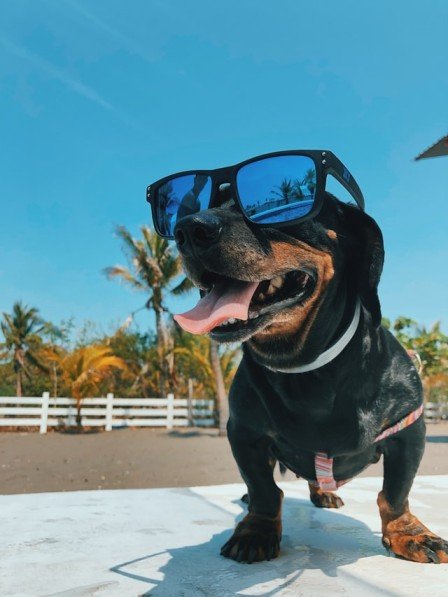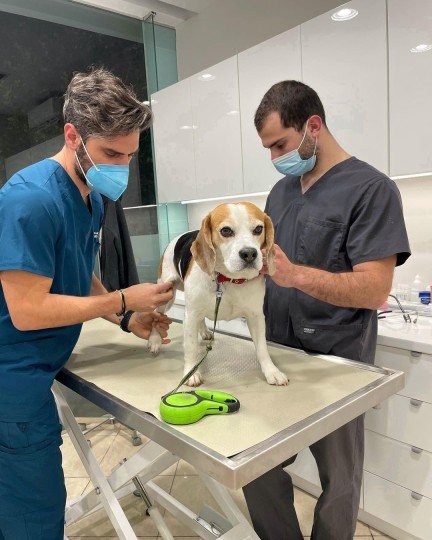For most of us, summer heat denotes vacation, relaxation, and lots of fun with family and our furry friends. While everyone else might enjoy prolonged hours under the sun and a good skin tan, your dog could be having the worst time of his life. Here’s why!
Dogs should not under any circumstances be subject to long hours under extreme heat. They will overheat easily. We’ll tell you why your dog gets so hot a little later in the article. But as a preliminary precaution, you should never expose your dog to extreme heat for long hours, as that comes with the risk of heat exhaustion or heat stroke.
If you don’t know what heat exhaustion and heat stroke mean, this article is your knowledge base. We’ll mark out for you the difference between heat exhaustion and heatstroke before listing the warning signs, the predisposing factors, what you should do as first aid, treatment for heatstroke in dogs, and what you should do to keep your dog safe from this medical emergency. Read on to find the details!
Heat Stress vs Heat Exhaustion vs Heat Stroke. What’s the Difference?
If you’ve come to the internet to understand heat stress, heat exhaustion, and heat stroke in dogs, you’ll find plenty of resources that use these terms synonymously. But are heat stress, heat exhaustion, and heat stroke synonyms?

To understand the terms, you first need to understand hyperthermia because heat stress, heat exhaustion, and heat stroke are three different levels of hyperthermia.
Hyperthermia in Dogs
Hyperthermia is the umbrella term used to describe situations when a dog’s body temperature exceeds the normal range (101.5°F/38.6°C). At this high temperatures, the pet cannot cool themselves through natural dog cooling processes like panting and nose or paw perspiration.
There are three progressive stages of hyperthermia:
- The first is heat stress
- Next is heat exhaustion
- Most serious is heat stroke
Heat Stress in Dogs
Heat stress is the mild type of hyperthermia. It occurs when your dog is experiencing higher body temperatures and is symptomized by panting and extreme thirst. However, your dog is still conscious and active at this point.
You need to bring your dog’s temperature down at this stage. Failure to do so can mean progression to the heat exhaustion stage.
Heat Exhaustion in Dogs
Heat exhaustion is a more serious level of hyperthermia in dogs. Body temperatures continue to rise, your dog pants heavily, and there’s increased thirst. Also, your dog begins to show signs of general body weakness.
While your dog will still be conscious during heat exhaustion, the pet can show delayed response to stimuli and may be too weak to move around. If you don’t treat heat exhaustion as an emergency, your dog will go into heat stroke.
Heat Stroke in Dogs
Heat stroke in dogs is a severe and life-threatening medical emergency. It occurs when your dog’s body temperature marks 41.1°C (106°F) or more. This high temperature compromises your dog’s vital organs and can lead to organ failure or even death.
At the heat stroke stage, the more your dog is exposed to heat, the greater the risk for organ dysfunction and eventual death become a likelihood.
But why are dogs so susceptible to heat and hyperthermia? That’s what we’ll tell you in the next section.
Why Do Dogs Get so Hot?
All living creatures experience heat. But each one expels heat in a different mode. While humans sweat to cool off their bodies, dogs don’t and instead pant and perspire minimally at the nose and paw pads.

If a dog is exposed to extreme heat such that he cannot keep up with the body’s need for cooling mainly through panting, then the pet’s body will heat up quickly, and body temperatures begin to rise above the normal range. The resulting risk is hyperthermia in the different levels discussed above.
It is very important that every dog owner knows when their dog is getting too hot. But how does a dog owner know this?
How Do I Know if My Dog is Getting too Hot?
There are several preliminary warning signs that show your dog is getting too hot. These are not clear cut out however and require you to be extremely vigilant.
Here are 3 warning signs that your dog may be experiencing a temperature surge due to extreme heat:
- Your dog is seeking a shady location to lie under.
- The dog is becoming restless and vocal (making whining sounds).
- Your dog shows a rectal temperature reading between 104°F (40°C) and 106°F (41.1°C)
With these warning signs in mind, it is important also to know what sources of heat put your dog at the risk of heat stress, heat exhaustion, and heatstroke
What Puts my Dog at the Risk of Heat Stroke?
Heat stroke in dogs is sadly often due to owner recklessness. However, this may not always be the case, as many dog owners may not be aware of dogs’ natural cooling modes and their susceptibility to overheating.
Knowing the causes of heat stroke in dogs can help owners protect their dogs from this potentially fatal condition.
Here are 10 situations that can put your dog at the risk of heat stroke:
- Leaving your dog in a car under the sun without proper ventilation is the primary cause of heat stroke in dogs.
- Vigorous or excessive exercise under the hot sun or when temperatures are very high.
- Leaving your dog in the yard on hot days without shade or adequate freshwater.
- Exposing your dog to a hair drier for a long period.
- Leaving your dog in an outside dog house without proper ventilation when temperatures are high.
- Being from a breed predisposed to heatstroke, especially brachycephalic breeds and Golden & Labrador retrievers.
- Muzzled dogs with a limited ability to pant during hot temperatures.
- Having an infection that causes fever and leads to hyperthermia.
- Being an obese dog with a weight exceeding the recommended average for the breed.
- Lack of acclimation when dogs move to a new area with higher temperatures than their former location.
Clinical Signs and Symptoms of Heatstroke in Dogs
The clinical signs of heatstroke manifest gradually in line with the three stages of hyperthermia: heat stress, heat exhaustion, and heat stroke.

Heat Stress Symptoms
- Excessive thirst
- Continuous panting
Heat Exhaustion Symptoms
- Heavy panting
- Drooling
- General body weakness and incidences of collapsing
Heatstroke Symptoms
- Excessive drooling
- Vomiting and diarrhea
- Disorientation
- Bright red or pale gums
- Bleeding on the skin or gums (internal bleeding may also occur in the GI system)
- Collapsing and seizures
- Fast breathing and increased heart rate.
- Muscle tremors
- Temperature levels above 106°F (41.1°C)
First Aid and Treatment for heat stroke in Dogs
The most appropriate action in heat-related dog illnesses is to act quickly with the first signs of heat stress before the situation aggravates to heat exhaustion or heat stroke.
This means offering prompt first aid to your dog following these steps:
- Remove your dog from the heat exposure spot and bring him to a shaded location with plenty of airflow. If available, put your dog in an air-conditioned room.
- Give your dog a drink of cool water. Do not give ice or ice water as that could cause a shock.
- Use a wet towel as a lying mat for your dog. Do not place the towel over the body, as this could trap the heat instead.
- Pass a damp sponge on the pet’s head, paws, and other body parts to speed up the cooling process.
- Ensure your dog does not engage in any physical activity to control temperature rise.
- If your dog’s body temperature is not dropping after a while, and you suspect he could go into a heat stroke, wet his body with a low-pressure hose, or slowly pour water on his body with a bucket. Do not put water on the dog’s face. Alternatively, direct a blowing fan towards your dog to help cool the pet.
- Take your dog to the vet for further medical attention.
Once at the clinic, the vet will give supportive heat stroke treatment. This means that the vet will treat any presenting clinical signs with the primary motive of getting your dog’s body temperature within the normal range.

Supportive heat stroke treatment care includes:
- Fluid therapy.
- Plasma transfusions to counter any form of bleeding.
- Blood pressure support.
- Giving gastroprotectants.
- Antibiotics, if there are signs of bacterial migration from the GI tract.
- Anti-seizure medications in case your dog is experiencing seizures.
The veterinarian may also carry out blood work and assess blood clotting times to determine if the heat stroke has been caused any damage to the organs.
What are the Long-term Consequences of Heat Stroke?
If your dog has heat stroke, it is highly likely that he can experience organ damage, especially to the kidney and liver. If this happens, the aftermaths of this damage will accompany your dog post heatstroke.
Unfortunately, a significant number of dogs do not make it out of a heat stroke. According to a 2017 study on the pathophysiology of heatstroke in dogs, the mortality rate from heat stroke in dogs is around 50%.
Because of the severity of heat stroke, the best cause of action is prevention.
What Can I Do to Prevent Heat Stress and Heat Stroke?
The best way to prevent heat stress and heat stroke in dogs is to keep your pet away from extreme heat.

Here are 7 ways you can prevent heat stress and heat stroke in dogs:
- Keep your dog indoors when outdoor temperatures are above 90°F (32.2°C). If your dog must go out, ensure it’s not for longer than 20 minutes. If your dog is of the brachycephalic breeds (Boxers, Pugs, Bulldogs, etc.), do not expose him to outdoor heat when temperatures are above 70°F (21.1°C).
- NEVER leave your dog in a parked car as temperatures inside a parked vehicle are always higher than the outside. On a day when outdoor temperatures are at 80°F (26.6°C), the temperature in a car can rise to 100°F (37.7°C) in 10 minutes.
- Always ensure that your dog has access to fresh, clean water and a cool place to relax.
- Avoid the hottest hours of the day for your daily walks with your dog and target the cooler hours of the day instead (early morning and late evening).
- Always keep your house cool in the hotter months of the year. If you are out of the house and your dog is home, do not turn off the AC, as the inside of a house can also heat up quickly when outdoor temperatures are high.
- If you are away for days during summer and your dog is home, opt to board your dog instead of having someone check on your pet a few times in the day.
- Know your dog’s medical history. Older dogs and those with preexisting medical conditions such as respiratory diseases, obesity, and heart disease should be given extra care to stay cool when temperatures are high.
What is the Prognosis for Heat Stroke in Dogs
The prognosis for dog heat stroke varies with a number of factors:
- The severity of the heat stroke (how high your dog’s body temperature rose).
- How long the dog suffered from hyperthermia.
- The promptness with which the affected dog was attended to during the emergency.
- Your dog’s health status prior to the heat stroke.
If your dog’s hyperthermia case was not severe and only went to the heat stress or heat exhaustion stages, the pet will recover quickly. However, many dogs who progress to heat stroke, the 3rd stage of hyperthermia, may experience permanent organ damage, and others even die.
You need to be aware that heat stroke complications can develop later after your dog is treated and survives. After having suffered heat stroke your dog is at a higher risk of subsequent episodes as the thermoregulatory system is weakened.
Key Takeaways
Heat stress, heat exhaustion, and heat stroke in dogs are often taken to mean the same condition. However, heat stress is the first and mild stage of hyperthermia in dogs, while heat stroke is the final stage of hyperthermia and the most severe and potentially fatal. Heat exhaustion is a transitional phase between heat stress and heat stroke.
Dog owners should act fast to reverse body temperature rise when their pet is still at the heat stress stage. Progressing to heat exhaustion and heat stroke puts your dog at greater risk of organ failure and possible death.
Target to remove your dog from the source of heat if you notice signs of heat stress, heat exhaustion, or heatstroke and offer first aid care to bring down your dog’s temperature. Then consult your vet immediately for further medical attention.
